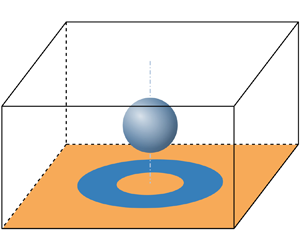No CrossRef data available.
Published online by Cambridge University Press: 02 October 2024

Direct numerical simulations of the droplet impact on a flat solid surface with an annular part are conducted. We investigate droplet impact on a superhydrophobic substrate with a superhydrophilic annulus to understand the formation conditions of droplets in different states. The location and size of superhydrophilic annulus are carried out through the phase diagram. We describe the formation process of droplets in three different states and the spreading radius with time to catch the rupture time of the film. Two different ruptures occur in the spreading stage or the retraction stage, respectively. The rupture times from these two mechanisms observed numerically are found to be a key factor resulting in partial rebound and lens-shaped/ring-shaped droplets. Finally, the influence of non-dimensional numbers on the formation of the ring-shaped droplet is demonstrated. The Weber number can alter the amplitude of the up and down oscillation on the droplet's upper surface, while the Froude number affects primarily the time to form the central penetrating hole. This gives the guidance and method to control the ring-shaped droplets formation time.